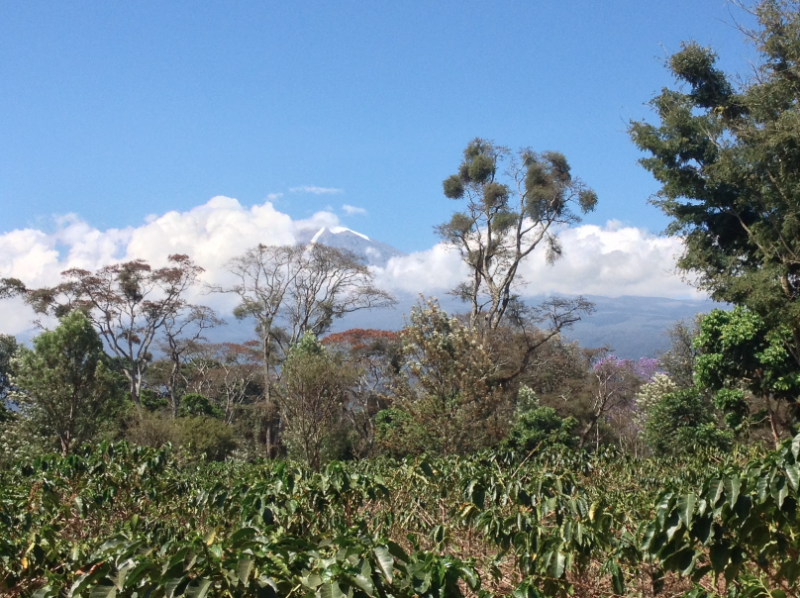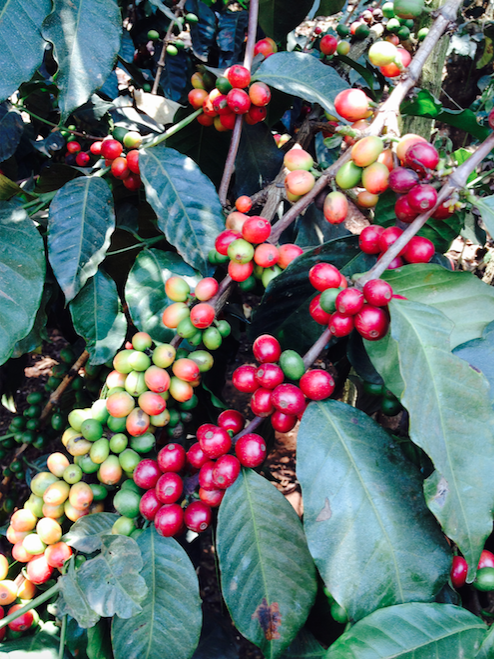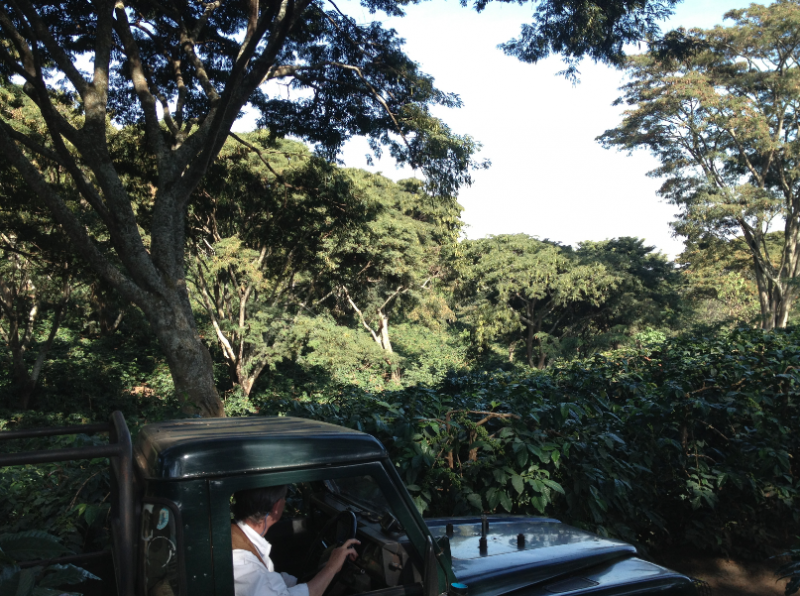Words by Dr Alessandro Craparo, Science of Coffee
Originally published in Issue 30 of The Coffee Magazine
People still read Goldilocks, right? Remember the great little fairy tale of Goldilocks and the three bears, in which a little girl chooses from sets of three items, ignoring the ones that are too extreme (large or small, hot or cold, etc.), and settling on the one in the middle, which is "just right". Well that’s kind of what growing coffee is like. It really enjoys a Goldilocks zone. One that isn’t too hot, too cold, too wet or too dry.
Coffea arabica is one of only two species of coffee – the superior of the two - used for consumption. Native to the cool tropical highlands of Ethiopia and South Sudan, Arabica grows throughout the highland tropics typically between 1000-2300 metres above sea level (masl). Grown predominantly by smallholder farmers, coffee is usually intercropped or grown with other subsistence crops such as beans, maize, bananas and a host of other fruit trees. If Arabica is the goodie, then Robusta is the baddie (I think I’ve been reading and playing with my daughters too much). Nevertheless, this is generally how the world views our two species of coffee. The goodie and the baddie. Robusta is native to the Congo Basin and is [was] thought to be more resilient “robust” of the two and suited to warmer temperatures. Whilst this is more or less correct, the world as we know it, is not completely black and white and the baddie can sometimes be quite nice.

Too many people, or too little coffee?
Unfortunately, trouble is brewing in this perfect little habitable coffee sector. A wide variety of complex issues - environmental, social and economic - risks the future of coffee production and the farmers reliant on it. Price volatility is a major issue which has intensified recently, and climate change threatens an increasing global supply of good quality coffee (the goodie and even the baddie coffee), while consumption and therefore demand, is expected to increase. We will come back to this supply and demand issue shortly.

Something happens to coffee at night
While everything including Donald Trump’s hair is blamed on climate change at the moment, coffee is unfortunately another species which is lumped into that group. We don’t necessarily subscribe to the alarmist views and suggest coffee will disappear, but the plant is definitely Goldilocks-ish. Within its happy growing environment in the Tropics, the plant (the goodie) is comfortable in a marginal temperature bracket ranging between 18-21°C. Outside of this envelope however, the plants metabolic processes begin to change and this can have a negative impact on coffee quality and production. The interesting thing about this, is that it seems to be mainly driven or influenced by night time temperatures. While the plant seems to be able to tolerate high daytime maximums, the warm night time temperatures are negatively influencing quality and production. By preforming a number of experiments on coffee in Tanzania and using decades of data, we found that increasing night time temperatures (as a result of changing climate) is reducing the amount of yield, or fruit, that trees are able to produce. This was the first evidence globally, indicating that the changing climate may be impacting coffee. More specifically, every 1°C rise in minimum or night time temperature will result in annual yield losses of approximately 137 Kg per hectare – this is roughly 60% of the average smallholder farmer’s current production in Africa. Now 5 years later, we have run several models on data from Vietnam on Robusta (the baddie) and it seems to tell the same story. Not only are the changes in climate impacting coffee yields and production, but different combinations of conditions, i.e. warmer temperatures and higher humidity makes it easier for pests and disease to (well, have sex) and affect coffee. For instance, the coffee berry borer and coffee leaf rust disease that struck farmers in Central America, Colombia and Peru nearly decimated an entire industry. Countries like Brazil and Uganda are predicted to lose more than 60% of their suitable coffee areas by 2050 and even the countries expected to see the least losses - like Colombia and Ethiopia - are predicted to lose up to 30% of their land suitable for coffee. However, this is only a guide and is dependent on a number of factors. The point is, people should be aware and the industry as a whole needs to make changes.

Most frighteningly, and this brings me back to the “too many people, or too little coffee” section above, new crop land is created for coffee production every day. As temperatures increase, producers within the growing band of 1000 - 1300masl in many areas of the globe, are struggling to maintain sufficient quality and yields. Even farmers at 1500masl, such as those on Mt. Kilimanjaro are becoming marginal. Moving upslope in pursuit of cooler temperatures is rarely feasible though. Despite the fact that most highland areas are already overpopulated and that most of these regions are encroaching on protected forests/biomes, who could just pick up their farm and move anyway? We are all very happy to shun the palm oil industry and avoid products that use this oil when forests are destroyed for its production, but what about when its coffee? Unfortunately, coffee cultivation also reaches more remote areas and deforestation is of particular concern in these regions since coffee lands are home to some of the world’s most delicate ecosystems which therefore threatens irreplaceable habitats of particularly high biodiversity and may damage critical ecosystem functions.
In order to meet the growing demand for coffee by 2050, we would need to double, or even triple the current 10,5 million hectares of land used for coffee production. However, more than half of this land is currently forested. In addition, only 20% of this is under any formal protection. Data on coffee land use change suggests that apart from Brazil, where increases in production are driven by technology, in almost all countries where coffee production is expanding rapidly – e.g. Vietnam, Indonesia, Ethiopia and Peru- new coffee crop lands are predominantly created by deforestation. Forests are converted into lightly shaded or full-sun coffee production systems with few or no trees. The annual increase is likely to be over 100,000 ha which is equivalent to an area of 548 football pitches deforested every day! The exact figure is difficult to assess, however we are getting closer by using new remote sensing technology. The demand for coffee is increasing and the changing climate makes it difficult to sustain production, but maybe, there are also just too many humans on this planet. Food demand, increasing greenhouse gasses, deforestation, pollution, water scarcity are all products of over population, if we solve that, we solve many other issues. I digress, maintaining coffee production sustainably, without impacting any further ecosystems is possible. Its not all doom and gloom and Goldilocks can adjust a few things here and there to get it “just right”.
Climate smart coffee
Enter climate smart coffee, sustainable intensification and agroforestry etc. We have many strategies, techniques and books of science to throw at the situation. And many of these are successful. Unfortunately, a substantial area of coffee production worldwide is being produced without shade. Only less than a quarter of coffee plantations have multi-layered, diversified shade systems. Planting and managing shade trees in a coffee agroforestry system can provide a multitude of environmental benefits, including carbon sequestration, ecosystem services and biodiversity conservation.
Shade-grown coffee is a common agroforestry practice which benefits ecosystems and biodiversity as shade trees provide a habitat for native birds, insects and wildlife. Agroforestry systems also provide benefits such as recycling of nutrients and soil organic matter, improved coffee quality and importantly, cooler temperatures. Shade-grown coffee also benefits the farmer through crop protection and diversity, thereby strengthening their livelihoods. However, each coffee growing region exists within its own unique niche and system, we can’t just take one strategy as a blanket solution and apply it globally. In order to be effective, we have developed many different models and tools in order to provide site-specific adaptation strategies or tailored solutions for each unique area and country. The potential to produce more coffee on the same land without harming the environment (or sustainable intensification) is also a very valuable solution in many areas of the globe.
Other adaptation strategies such as breeding more tolerant varieties (which often involves adding some of the baddie to the goodie, so to say) is an ongoing process and we are currently part of a multinational projects called BREEDCAFS - Breeding Coffee for Agroforestry Systems. While it is great to have newer varieties that are high yielding, pest and disease tolerant and still taste good, this unfortunately takes several decades to achieve.
Similar to many of the global issues we face today, it’s the small changes that eventually lead to a difference. It can’t, and won’t happen overnight. One thing is certain, if we want to keep Goldilocks happy, we need to attempt to reduce our ridiculous burden and necessity we place on our planet in every way. Remember to ask your barista to make your coffee “just right” tomorrow morning.

Dr. Alessandro Craparo is a climate scientist and owner of Science of Coffee in Durban. He holds a position as a postdoctoral fellow at the International Centre for Tropical Agriculture (CIAT) where he works on climate change, plant physiology, adaptation and mitigation mechanisms, predominantly on coffee and related tropical crops.